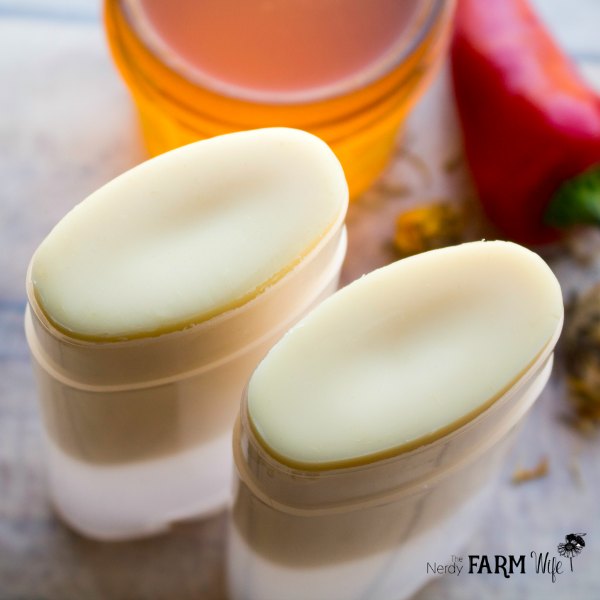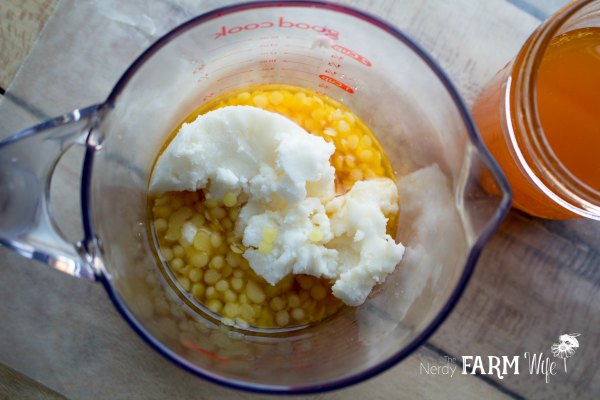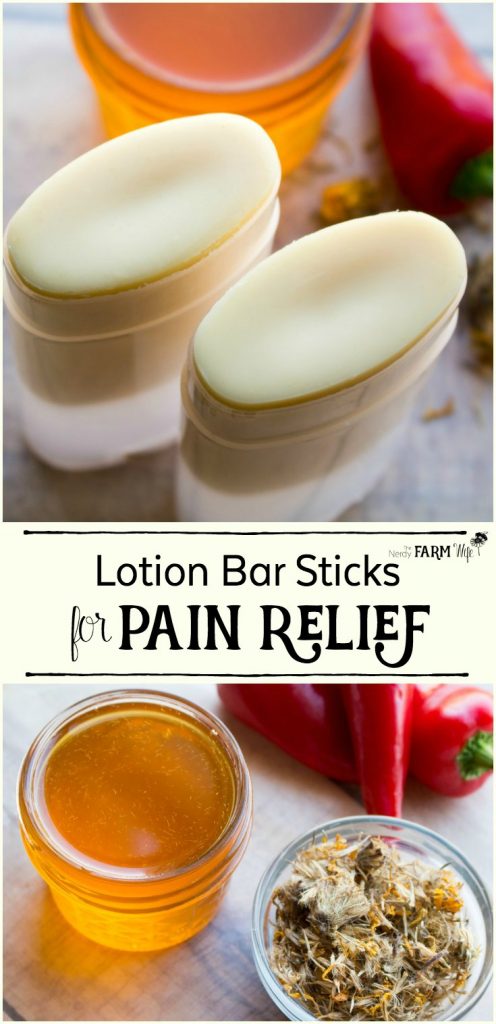Lotion Bar Sticks for Pain Relief {Arthritis and Achy Muscles}

This recipe was inspired by newsletter subscriber Bonnie, who was seeking a lotion bar in a deodorant stick container for achy muscles and arthritic pain.
It features a trio of herbs:
- cayenne – contains capsaicin which has been shown to offer relief from arthritic and other types of pain
- ginger – traditionally used to warm, increases circulation and relieve pain when applied topically
- arnica flowers – traditionally used to treat swelling, bruising and arthritic joints
(Sources: Making Plant Medicine, by Richo Cech; PubMed: here, here, here, here, here, here.)
The lotion bar stick format is especially handy for products made with cayenne, since you want to be sure not to rub it in your eyes or mucous membranes, as it can burn.
Some links in this article are affiliate links. If you click on one and make a purchase, I earn a small commission for sending a customer their way. I only recommend products I’ve personally used and like. :)

Step One – Make the Infused Oil
In a small heatproof 8 ounce glass container or jar (like these), add 2 tablespoons dried arnica flowers, 1 tablespoon cayenne powder and 1 tablespoon ginger powder.
Fill the jar the rest of the way with oil. I like to use rice bran, sweet almond or sunflower oil, but feel free to use your own favorite oils for this project. Stir and add more oil if needed.
Set the jar down into a saucepan containing a few inches of water and warm it over low heat for one to two hours. (Alternatively, you can cover the jar with a cap and let the oil infuse at room temperature for around 4 weeks.)
After the oil is infused to your satisfaction, strain it through a very fine mesh sieve and/or cheesecloth, leaving the powdered sediment behind in the infusing jar (to avoid grittiness) then use in the following recipe.

Step Two – Make the Lotion Bar Sticks
If you don’t own a scale, try using roughly 1/4 cup each of beeswax, oil and shea butter.
If you don’t get quite the texture you’re looking for, melt the mixture again and add more wax for added firmness, or more oil for a softer consistency.
- 1.3 oz (36 g) beeswax
- 1.7 oz (48 g) herb-infused oil from above
- 1.7 oz (48 g) shea or mango butter
Combine the beeswax, oil and butter in a heatproof jar or container. (Use a recycled tin can for easiest cleanup.)
Set the container down into a saucepan containing a few inches of water and heat over medium-low heat until melted.
Remove from heat and allow to cool for a few minutes before pouring into empty deodorant containers.
(I bought my containers from Amazon, though since the time of my purchase, it appears they may have changed them to solid white instead of clear.)
I purposely left this batch unscented since I’m giving one to a relative with asthma who is sensitive to scents, including many essential oils, but for my next batch I plan to add Tei Fu Oil, my favorite pain relief essential oil blend.
For more essential oil and pain information, you might also enjoy browsing through a search on PubMed (like THIS ONE) or the wonderful book, The Complete Aromatherapy & Essential Oils Handbook for Everyday Wellness.
How to Use Lotion Bar Sticks for Pain Relief
Rub the lotion bar stick over sore and achy muscles and joints. Be careful not to get it in your eyes since cayenne pepper can burn.
Without added essential oils, this pain relief stick is mild and gentle. For a stronger effect, consider adding Tei Fu or another essential oil blend (see information about that above.)



Jan- After I learned about tei fu oil from an earlier blog post, I purchased it and LOVE it. However, that recipe called for pouring an entire bottle of tei fu into the salve mixture. You didn’t say how much of the tei fu to use for this formula. I have 2 questions – how much would tei fu do you recommend for this formula and, when you use an entire bottle how do you get it out of that tiny little bottle? Do you sit there and shake out every little drop? It seems as if that would take forever!
Hi Susan! I love tei fu oil too – it’s amazing stuff! I’m still tinkering with amounts, but it’s quite possible the recipe could support an entire bottle of tei fu oil, since it’s already diluted in a carrier oil and can be safely applied directly to your skin as is. I agree 100% – that tiny bottle can be quite tedious to use! I shake the oil out drop by drop too. I’ve looked for larger bottles, but so far haven’t found any, so suspect it only comes in that tiny size. :)
Thank you so much, Jan for creating the arthritis bar that I suggested. It really made my day and I can’t wait to try it. On top of it all, it’s my birthday tomorrow, 1/27 and I feel like I got a Birthday present from you. I’m honored. Thanks again.
Hi Bonnie, Thank you for sharing your idea and inspiration! Also happy birthday!!! :)
How much essential oil would you add?
Thanks
Hi Johnny! That’s something I’m still experimenting with so don’t have a recommended amount yet. I made a new batch with 1/3 bottle of tei fu oil the other day and think with the next batch I’ll use more – probably 1/2 bottle. Tei fu oil is already diluted in a base of carrier oil, so it can be used at a higher rate than straight essential oils; it just takes a few test batches to get the right amount. :)
Thanks for the great recipe! I’m going to purchase the Tei Fu Oil but how much would you recommend adding to this recipe? Thanks, Jan!
Hi Kathleen! I’m still testing that out, so don’t have a final amount quite yet. I made more the other day and used about 1/3 of the tiny Tei Fu oil bottle and thought it was still a little weak, so next time will add more. Tei fu oil is already diluted with oil – I’ve applied it directly on my skin for a headache and it doesn’t irritate, so it takes a little experimenting to get an optimal amount. :)
To make this recipe with Tei Fu Oil would you just replace some of the herb infused oil? How much would you recommend using?
Hi Teri! You would just add the tei fu oil (or other essential oils) to the melted mixture. You don’t have to remove any of the herbal infused oil since it’s a relatively small amount of tei fu/essential oils being added. :)
I’m living with my mum who has dementia. That really limits my ability to creating and making things. Is there somewhere I can purchase this bar already made?
Also, because of the dementia my mum forgets not to rub her eyes after using some of the cremes and salves with ingredients that might cause burning. Any suggestions?
Hi Cyndi! I’m so sorry to hear about your mom’s health. You may be able to find something ready made on Etsy:
https://www.etsy.com/search?q=lotion+bar+stick
Since she might be able to rub it in her eyes, you’d probably want to avoid anything with cayenne or menthol in it – both would be uncomfortable in her eyes.
Perhaps something based on arnica could be helpful: https://www.etsy.com/search?q=arnica
May I ask where you are finding tei fu oil?
Hi Heather! I find it at my local health store, but you can also buy it on Amazon:
https://www.amazon.com/Tei-Essential-Oils-0-17-FL/dp/B000J4GC5E
Love this idea!!! Wondering how many and what size deodorant bottles does this recipe make? Thanks again for the great idea ?.
Hi Leah! The recipe exactly filled the 2 tubes shown which are 2.12oz/60g/60ml. :)
Thank you so much for sharing this!
Hi Annmarie, You’re welcome & I hope you find the recipe useful! :)
My lotion sticks are a orange color just wondering why yours are more beige?
Hi Karen! You probably have a more concentrated oil than I do – that’s a good thing! It should be nice and effective. :)
Hi Jan,
I’m having a hard time to find the tei fu oil blend. I have however on hand oil 31, will that work too? If so how much will you recommend to add for this recipe.
Otherwise what eo would you recommend and how many drops of each.
Thank you so much in advance.
Hi Ana! I’m not familiar with oil 31, but you could try creating your own pain blend. Here’s a good formula from Learning About EOs:
https://www.usingeossafely.com/wp-content/uploads/2016/10/Create-Your-Own-Pain-Blend-2.jpg
and it’s from this blog post: https://www.usingeossafely.com/using-essential-oils-for-pain/
Can you save the left over infused oil?
Hi Kathy! Yes, you can save the leftover infused oil. I usually top off the jar with some fresh oil & let it keep infusing with the herbs to use another time. :)
Hi Jan! I just saw this and I’m wondering if I can skip arnica flowers? or what can I sub for arnica flowers?
Hi Cyn! Arnica flowers add a lot to this recipe so it’s most ideal to include them, but I think you could try swapping them out for one or more of: comfrey, dandelion, or goldenrod. If you give it a try, I’d love to hear how the substitution works! :)
Can I just buy one from you?
Hi Candis, Thanks for asking! I’m not set up to sell products, but if you check Etsy, they have several pain sticks available: :)
https://www.etsy.com/search?q=pain%20relief%20stick
Can you substitute the Arnica oil for the Arnica flowers?
Hi Rachel! Yes, if you have arnica infused oil already, you could use that for part of the oil allowance.
Something like this should work nicely:
https://www.mountainroseherbs.com/products/arnica-herbal-oil/profile
If I add half a bottle of tei fu, do I have to change the amounts of the shea butter or beeswax to ensure it solidifies correctly?
Hi Kate! The tei fu oil is a tiny bottle and very concentrated, so it doesn’t normally change the texture of the pain bars. Often, no changes should be needed, but sometimes butters can vary in texture/consistency, plus your weather may play a part (hot weather makes things softer, cold weather harder) – if you find the bars are a bit too soft or hard, you can remelt them and add more wax to harden, or more oil to soften. :)
Thank you for this! I made a batch and just love them. They work!!
Hooray! So happy to hear that they work well! :)
What do you think the shelf life is for this item?
Thanks I love mine!!
Hi Anita! The shelf life should be at least 9 months to a year – though it could be much longer. Since there’s no water content, it shouldn’t mold or spoil, it’s just that the oils within will eventually turn rancid when they age – you’ll be able to tell when it’s time to replace when the stick starts smelling like old or rancid oil. So happy you like the recipe! :)
Can you leave out the beeswax and Shea butter and put in roller bottle instead of bar..??
Hi Anita, Yes! You’re exactly right – that would work to make a roll-on pain oil. Infused oils can go in roller bottles, be turned into salves or lotion bars, or used in lotion/cream recipes.